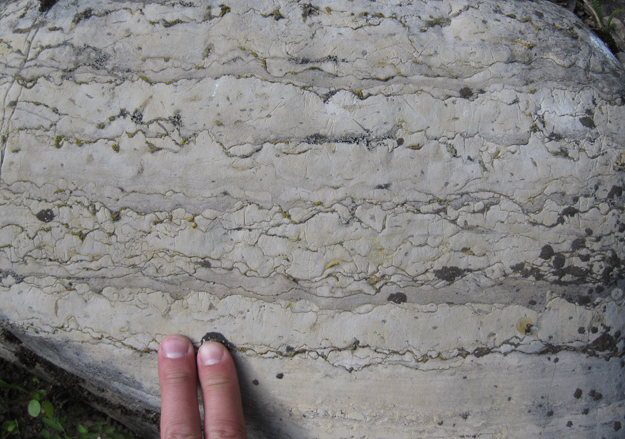
Stylolites (pressure solution seams) in limestone of Mississippian age, exposed on the side of a rounded boulder in Hyalite Canyon, Gallatin Range, Montana. These stylolites, like most, are bedding-parallel, and thus most likely formed due to the weight of the overlying rock. Calcite, the dominant mineral, goes into solution under pressure, and insoluble material, like organic matter and clay, accumulates along the dissolution surface, producing a dark, wiggly line. Here, multiple stylolites have converged and overprinted one another, resulting in a mutli-level “oscilloscope” look.

I think it’s “styolite.” But they’ve sure got style. ;-D
Looks like it’s both, based on a quick googling…. I always thought it was derived from “stylus,” like the little pen that draws the seismogram all EKG-style. Looks like even Marli Miller swaps back and forth between the two, however: http://www.earthscienceworld.org/images/search/results.html?Keyword=Secondary%20Structures
Anyone have an AGI Dictionary of Geology handy? I’m in Montana, and don’t have ready access to a definitive reference.
Not definitive, but: Wikipedia spells it with an “l” too…
Think you’re right, Cal. Sort of like grey and gray.
Here’s a scan of the relevant page from the AGI lab manual, now that I am back in the office and can access it. “Styolite” is absent.
Ah, Mississippian carbonates with stylolites–I see you’re getting closer to my stomping grounds (Alberta Rockies).
My AGI Dictionary spells it “stylo”, so does my Penguin (British) Geo dictionary, and the Oxford American Dictionary widget on my Mac, which says the origin is Greek “stulos” (= column) + -lite. Like you, I always thought “stylo-” had something to do with drawing a line. Dunno quite how the “column” comes into it. I’ve gotta think any spelling that uses “styo-” has to be a typo.
Happy holidays!
The column part actually makes a ton of sense – because in three dimensions, the stylolites are indeed column or needle-shaped. We see a 2D cross-section of those needles as up and down wiggles on a line (the overall stylolite seam plane).
Thank you for your image and explanations. I am a geologist in Turkey. I study evaporites in Tuz Gölü basen. do you have another picture about stylolites
Oh. I’m sure I’ve got a few others kicking around here somewhere. I’ll have a look-see, and post them in the future if I find any worth sharing.